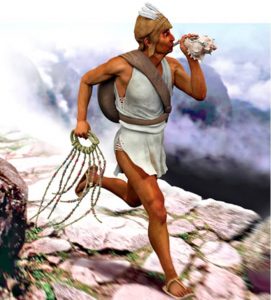 The Inca had an advanced road system, but they had no written language. How could they possibly run an empire of twelve million people that spanned the length of a continent without writing?
The Inca had an advanced road system, but they had no written language. How could they possibly run an empire of twelve million people that spanned the length of a continent without writing?
The Inca came up with some clever strategies. For instance, they invented a means for counting and record-keeping using a quipu (/kee*poo/). A quipu was a piece of string that had shorter strings of various colors dangling from it. By tying knots in a certain pattern on a quipu, an official could record how many warriors were headed for a village or how much corn was in a storehouse.
The Inca also used messengers trained to run short distances to carry news. Since the Inca had no written language, these messengers did not carry a written note. Instead, a runner memorized his message and sprinted to a station, a mile or so away. There, the next runner would be waiting. Without slowing the pace, the second messenger ran alongside the first messenger to hear the message. Then the second messenger continued on.
The system was fast! A message could travel 150 miles in a day. This meant news could travel all the way from Quito (/kee*toh/) to Cuzco in a little over a week. In the 1860s, the famous pony express riders of the American West were only able to cover about two hundred miles a day—and they rode on horseback!